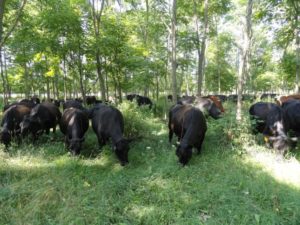The Art of Silvopasturing: A Regional Conference
The practice of Silvopasturing is causing quite a buzz these days. It was a fairly new concept to me until a year and a half ago, a concept that brings together forestry management and grazing management into one single system of sustainable woodland grazing. It can diversify income by tapping into products of trees, tree products, forage, and livestock. Trees can be introduced to the pasture or pasture introduced to the trees. Management is the key to reduce the likelihood of soil compaction, debarking of trees, and trampling and browsing of regeneration.
But in the modern world of invasive plants, high land ownership costs, and other challenges to healthy and sustainable woodlands, it is worth taking another look at livestock grazing as an acceptable and valuable tool for the management of some woodlots. The purposeful and managed grazing of livestock in the woods, known as silvopasturing, differs from woodlot grazing of the past in that the frequency and intensity of the grazing is controlled to achieve the desired objectives. New fencing systems, a better understanding of animal behavior and the evolution of “management intensive grazing” have enabled us to gain the necessary level of control over livestock to achieve positive impacts from woodland grazing.
Silvopasturing isn’t for every woodland owner or every woodlot as it requires a commitment to caring for animals and enclosing portions of the woods with a secure fence to keep your animals in and predators out. Wooded areas on poor growing sites, rough terrain, or with difficult access would obviously have fewer advantages for successful silvopasturing than the converse. But the most important key for success is skilled management of the system. This requires considerable knowledge of both silviculture and grazing. If grazing and silviculture are the “artful application of science”, then combining the two systems in certainly a fine art! But this shouldn’t discourage the novice from exploring the potential of silvopasturing on their property, even though results are likely to improve with increased skill and experience.
Cornell Cooperative Extension is looking to assist in providing an educational opportunity to learn more about the art of silvopasturing. The 2-day conference will be November 7 and 8, 2011 at the Watkins Glen Harbor Hotel, 16 North Franklin Street, Watkins Glen, Schuyler County. The goals of the conference are to broaden a collective understanding of silvopasturing and its applications in the Northeastern US across multiple professions and stakeholders, identify opportunities and challenges to its implementation, and develop networks for collaborative research, learning and promotion of silvopasturing activities. It is open to the public, with land use and conservation professionals, foresters, graziers, woodland owners and members of the academic community are especially encouraged to attend.
The multistate list of presenters represents areas of in the East where the practice is in place. Highlights, though not all the speakers include John Hopkins, Consulting Forester from Bloomsburg, PA will discuss restoration and revitalization of an Appalachian farm. Charles Feldrake with USDA Agricultural Research Service’s Appalachian Farming Systems Research Centerin Beaver, West Virginia, will talk about their applied research there. Mike Jacobson with Penn State University will cover great opportunities and challenges in the Northeast. Three of our speakers are coming from University of Missouri Center for Agroforestry. Dusty Walters, Larry Godsey, and Gene Garrett will at length focus on silvopasture design, implementation and impacts. Doug Wallace is the NRCS Lead Agroforester at the USDA National Agroforestry Center in Lincoln, Nebraska will provide an overview of current resources and assistance available for practitioners and researchers. Brett Chedzoy, CCE, is a forester and practitioner of the silvopasturing. He and his wife, Maria, will host the field tour/discussion portion and conclusion of the conference. We will see first-hand their system in place.This is by no means a complete overview of the conference!
Every attempt is being made to keep the cost of the conference as reasonable as possible with support coming from National Agroforestry Center, Upper Susquehanna Coalition, Cornell’s Department of Natural Resources, as well as others in the works. An agenda and registration for the event can be foundonline at http://nesilvopasture.eventbrite.com. A block of rooms are reserved at the hotel; contact them on the web at www.watkinsglenharborhotel.com or 607-535-6116.
For more information on the event, contact Brett at 607-742-3657 or bjc226@cornell.edu.


